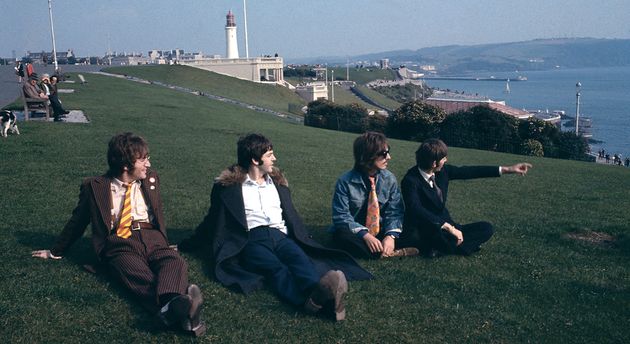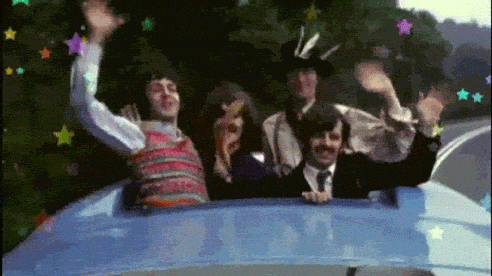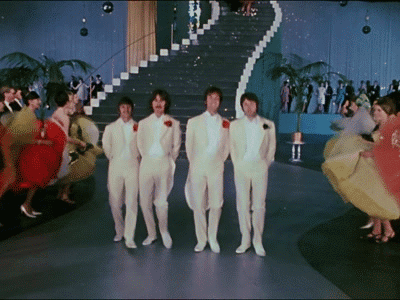50 Years Of Beatles: ‘The Bigger They Are, The Harder They Fall’
Ken Womack
12 Sept 2016

John, Paul, George, and Ringo on the set of “Magical Mystery Tour”
On September 11, 1967, the Beatles undertook a fateful course—one that would humble them profoundly in the coming months: with the recent triumph of Sgt. Pepper’s Lonely Hearts Club Band and the international simulcast performance of “All You Need Is Love” under their belts, they tried their hand, bizarre as it may seem in retrospect, at becoming film directors.
John Lennon, for one, recognized the dangerous waters that the Beatles had been trolling in since manager Brian Epstein’s untimely death only a few weeks earlier. As Lennon later remarked, “I knew that we were in trouble then. I didn’t really have any misconceptions about our ability to do anything other than play music. And I was scared.”
To Lennon’s credit, he understood intuitively that while their work as composers and their musicianship may have been unparalleled, such skills didn’t necessarily prepare them for making movies. But with Paul McCartney eager to see the Beatles make their mark in those post-Pepper, post-Epstein days, they amiably trudged on.
McCartney fashioned the idea for the group’s latest film project on traditional English day trips to the countryside. As McCartney later observed, “In England, they have these things called mystery tours. And you go on them and you pay so much and you don’t know where you’re going.” Clearly, the Beatles adopted this concept literally as their movie’s central aesthetic, essentially making things up as they went along. And with that, the Magical Mystery Tour was born.

Renting a 62-seat bus as their mobile prop, the band mates and their entourage traversed the English countryside, hampered much of the time by a growing phalanx of media and fans who trailed their every move. Eventually, the production settled for several days in the large empty hangars of Kent’s West Malling Air Station, which doubled as their soundstage. At the end of October, McCartney traveled to Nice with a cameraman to film a daydream sequence, effectively bringing the movie’s principal photography to a close. All that was left for the group was a little slapdash post-production work with some color filters and film loops.
While the quality of the film may have still been in doubt at this point, the Beatles’ music was sublime as always, including magnificent new fare like “I Am the Walrus” and “The Fool on the Hill” adorning the soundtrack. Indeed, the UK release of the Magical Mystery Tour EP in early December met with success throughout the holiday season, as did the LP release in the United States. Yet 1967 would end with a shudder for the Beatles—and most particularly for McCartney, who expected the movie to validate the band’s wide array of talents in art forms beyond the boundaries of pop music.
As perhaps their single greatest artistic failure, the film version of Magical Mystery Tour showcases the band members in a beguiling series of burlesques that is memorable solely for its utter disarray. The movie’s chaotic narrative features musical iterations from Beatles films past, including a marching band’s intentionally cloying version of “She Loves You” and a string arrangement of “All My Loving” during a romantic interlude involving Ringo’s wanton Aunt Jessie (Jessie Robbins) and staid courier Buster Bloodvessel (Ivor Cutler).
In the movie’s finest moments, the Beatles perform quasi-music videos for “The Fool on the Hill,” “I Am the Walrus,” and “Blue Jay Way.” The film reaches its ridiculous nadir in a variety of nonsensical skits—set in, of all places, an army recruiter’s office and a strip club—that attempt to recall the zany vignettes inherent in A Hard Day’s Night and Help!

The poor reviews that Magical Mystery Tour received after its debut on Boxing Day (December 26th) on the BBC—which premiered the film in black and white, thus mitigating its multicolored virtues—revealed the awful reality of its failure. ABC television, which owned the rights to broadcast Magical Mystery Tour in the United States, opted not to air the film at all.
The reviews, not surprisingly, were swift and merciless. “The bigger they are, the harder they fall. And what a fall it was,” James Thomas wrote in the Daily Express. “The whole boring saga confirmed a long held suspicion of mine that the Beatles are four pleasant young men who have made so much money that they can apparently afford to be contemptuous of the public.” Meanwhile, the Daily Sketch couldn’t help poking fun at the Beatles’ recent forays into Eastern mysticism: “Whoever authorized the showing of the film on BBC1 should be condemned to a year squatting at the feet of the Maharishi Mahesh Yogi.” For its part, the Daily Mirror condemned Magical Mystery Tour as “Rubbish . . . Piffle . . . Nonsense!”
But for the Beatles themselves, there was simply no way to spin the filmic disaster in their favor: it had proved to be a critical drubbing that was genuinely difficult to stomach—especially after the artistic heights that they had enjoyed with Sgt. Pepper only scant months before.

__________
Ken Womack is an internationally renowned Beatles authority regarding the band’s enduring artistic influence. His latest book, Maximum Volume: The Life of Beatles Producer George Martin (The Early Years: 1926-1966), is forthcoming in 2017. His previous Beatles-related books include Long and Winding Roads: The Evolving Artistry of the Beatles and The Beatles Encyclopedia: Everything Fab Four. You can learn more about Ken’s work at kennethwomack.com.

No hay comentarios:
Publicar un comentario